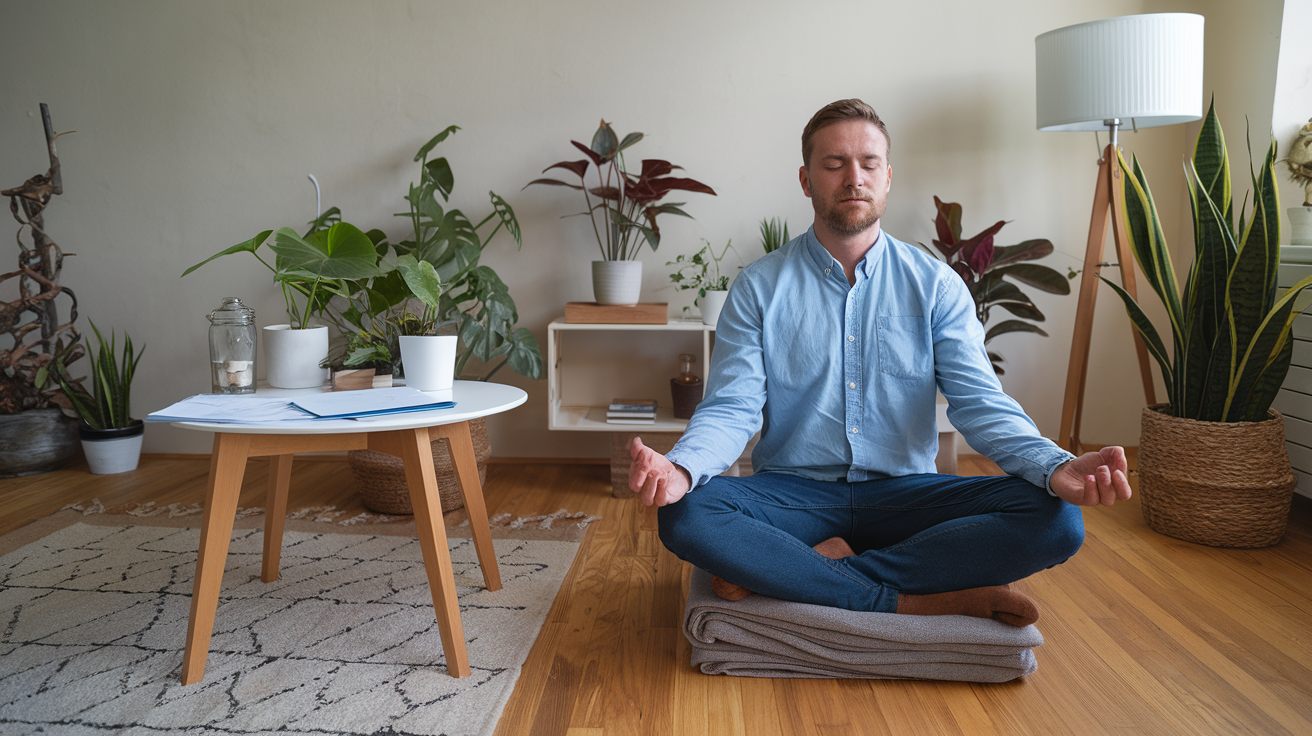Have you ever wished you could press a reset button for difficult memories?
Your mind replays that moment over and over. The stress builds up, sleep gets harder, and daily life feels heavy. Many people face these struggles alone, thinking there’s no way to change how their brain processes these memories.
Self-EMDR can be used at home to help your brain handle tough memories better. While it’s not magic, it gives you tools to work through painful thoughts and feelings on your own time, in your own space.
This guide will teach you the steps for safe self-EMDR practice. We’ll walk through what works and when you need extra help.
Let’s find ways to make those hard memories feel lighter.
What is EMDR Therapy

Eye Movement Desensitization and reprocessing therapy helps people heal from hard memories. It uses eye movements to change how your brain handles tough experiences. A trained expert guides you through this process.
During EMDR sessions, you follow a moving light or hand with your eyes. At the same time, you focus on memories that cause you stress or pain.
Your brain starts to process these memories differently through EMDR. The goal is to make painful memories feel less upsetting when you think about them later.
EMDR sessions happen in a safe space with a trained professional. You stay awake and in control while working through your memories step by step.
This therapy works well for many types of problems. People often feel better after 6 to 12 sessions, with each session lasting about 60- 90 minutes.
Phases of EMDR Therapy
- Phase 1: History Taking – Your therapist learns about your background and creates a treatment plan. They help pick which memories to focus on first.
- Phase 2: Getting Ready – You learn stress relief methods like deep breathing. These tools help you stay calm during and between sessions.
- Phase 3: Testing – You choose a memory to work on. You share how it makes you feel and what thoughts come up.
- Phase 4: Working Through – This phase uses eye movements while focusing on the memory. Your brain starts to process the stored information.
- Phase 5: Installing – You link good thoughts with the memory. The brain learns to store memory better.
- Phase 6: Body Check – You notice if your body feels tense when thinking of the memory. More processing happens if needed.
- Phase 7: Closing – The session wraps up safely. You use calming methods to feel steady before leaving.
- Phase 8: Checking Progress – You and your therapist look at how far you’ve come. You make plans for future sessions if needed.
How to Practice EMDR Therapy at Home
EMDR techniques can be useful tools for daily life. Many people use them to cope with stress and painful memories.
While home methods can’t replace professional therapy, learning basic techniques lets you support your mental health between expert visits.
Below written are some of the ways to practice EMDR therapy at home.
1. Light Bar Apps

Using an EMDR app can help you process emotions and reduce stress effectively. Follow these simple steps to ensure a smooth and comfortable experience.
- Download EMDR apps on your phone
- Set the speed that feels right
- Use in a quiet, dark room
- Follow the moving light
- Take breaks when needed
2. Butterfly Hug Method

The butterfly hug method exercise can help calm your mind and improve focus. The process of the exercise is given below which one should definitely do:
- Cross your arms over your chest.
- Tap shoulders slowly, left, then right
- Keep a steady rhythm
- Focus on your memory
- Stop if you feel too upset
3. Finger Movement

Finger movement exercises in self-EMDR involve moving your fingers side to side while tracking them with your eyes. This helps stimulate bilateral brain activity, promoting emotional processing and reducing distress.
- Hold one arm out straight.
- Move your finger from side to side
- Follow with your eyes only
- Keep head still while tracking
- Start slow, then find your pace
4. Sound Methods

Listening exercises can help improve focus and relaxation. Try these simple steps to engage with sound mindfully, which will help you feel better:
- Use headphones
- Play tones that switch ears
- Keep volume comfortable
- Notice how you feel
- Stop if sounds bother you
5. Safe Practice Tips

Creating a safe and supportive environment can make a difficult moment easier. These activities will make you feel better and provide a secure environment.
- Set short time limits
- Practice in a calm space
- Keep tissues nearby
- Have your phone ready for help
- Tell someone you trust
6. Key Rules for Home Use

Managing stress takes patience and balance. While at home, follow these steps as they can make challenges more manageable and less overwhelming.
- Start with small worries
- Don’t push yourself too hard
- Take multiple breaks
- Note your feelings
- Stop if it is too intense
Who Needs EMDR Therapy
| Category | Examples |
|---|---|
| People Dealing with Past Events | Went through a car crash, Lost someone close, Had a scary medical event, Faced physical harm, Experienced childhood problems, Lived through natural disasters, Saw upsetting events, Had work accidents |
| People with Current Life Issues | Can’t sleep well at night, Feel jumpy or scared often, Have trouble at work, Struggle in relationships, Find it hard to trust others, Feel sad most days, Worry too much, Get angry easily |
| People with Physical Signs | Get frequent headaches, Feel tired all the time, Have unexplained pain, Notice muscle tension, Experience panic signs, Have trouble breathing, Feel sick to the stomach, Get racing heartbeats. |
| People with Daily Struggles | Fear certain places, Avoid specific situations, Have test anxiety, Fear public speaking, Worry about driving, Feel nervous in crowds, Struggle with change, Have low self-worth. |
Benefits of Performing Therapy
- Therapy can make life better in many ways. People often feel more at peace with themselves after starting sessions.
- A therapist provides a safe place to talk about feelings without any judgment. You can share your thoughts with someone who listens and understands you.
- Working with a therapist teaches useful ways to handle stress and tough situations. These skills stay with you long after your sessions end.
- Regular therapy sessions help build stronger relationships with family and friends. You start to see patterns in how you act with others.
- Most people sleep better and feel less worried after starting therapy. Their minds become clearer, and daily tasks feel more manageable.
- Therapy helps set good boundaries and say “no” when needed. This makes your daily life much easier.
- Learning to spot unhelpful thoughts and changing them into more positive ones makes a big difference. This new skill improves your outlook.
- The tools learned in therapy work in many parts of life. They help at work, at home, and in your free time.
What Conditions and Problems Does EMDR Treat
| Conditions and Problems Treated by EMDR | Description |
|---|---|
| Trauma and Distressing Memories | EMDR helps individuals process and heal from upsetting events, reducing the emotional distress linked to memories. |
| Bad Dreams and Flashbacks | EMDR reduces the frequency and intensity of nightmares and flashbacks, helping individuals regain control. |
| Anxiety and Panic Attacks | EMDR has been shown to alleviate symptoms of anxiety and panic attacks, promoting a sense of calm. |
| Sleep Issues | EMDR therapy can help improve sleep by addressing racing thoughts and promoting relaxation. |
| Depression and Long-Term Sadness | EMDR works with both past and present causes of sadness, helping individuals experience emotional relief. |
| Trust Issues | The therapy explores past experiences that contribute to trust difficulties, helping individuals heal. |
| Physical Pain Linked to Stress | EMDR helps reduce physical pain related to stress by addressing the mind-body connection. |
| Low Self-Worth and Confidence | EMDR therapy supports self-esteem improvement and helps individuals feel more confident and empowered. |
What is the Recovery Time from EMDR
- Individual Response Times: Every person responds to EMDR treatment at their own speed. Some notice changes within a few weeks, while others need more time.
- Number of Sessions Needed: Most people need 6 to 12 sessions to see good results. Sessions usually happen once or twice each week.
- Immediate After-Session Effects: Right after each session, you might feel tired or have strong feelings. This is normal and typically lasts one or two days.
- Speed of Improvement: Some people feel better after just three or four sessions. Others may need more sessions to work through their concerns.
- ProcessingPeriod: The brain needs time to process what happens in each session. Taking breaks between treatments helps with this process.
- TreatmentPacing: Your therapist will work with you to set a good pace for treatment. The schedule depends on how you feel and respond.
- PhysicalResponses: Physical symptoms like headaches might show up after sessions. These usually go away within 24 hours.
- SleepChanges: Some people notice their sleep patterns change during treatment. This often gets better as your body adjusts to the therapy.
- Self-Care During Recovery: Taking care of yourself between sessions speeds up recovery. Getting enough rest and staying active helps the process.
Conclusion
Self-EMDR methods work best when used as part of your mental health care plan. Regular practice with these tools helps build new ways to handle stress. Start small and notice what works for you.
Remember to use these techniques gently. Stop if you feel too much stress. Trust your mind’s natural healing power and take time to process. Your mental health matters.
Find what fits your needs and keep working with your therapist for the best results.
Do you use self-EMDR methods? Share your tips in the comments below.
Frequently Asked Questions
How Long Should Each Self- EMDR Session Last?
Each self-EMDR session typically lasts between 20 to 45 minutes. The duration depends on the individual’s needs, the intensity of the memories being processed, and the overall progress made.
Do I Need Special Equipment for Self- EMDR?
No special equipment is required for self-EMDR. It mainly involves focusing on a target memory while using bilateral stimulation, such as tapping or eye movements, which can be done without any tools.
What Should I Do if I Feel Overwhelmed During Self-EMDR?
No special equipment is required for self-EMDR. It mainly involves focusing on a target memory while using bilateral stimulation, such as tapping or eye movements, which can be done without any tools.
Can I Practice Self-EMDR for Any Problem?
Self-EMDR works best for mild stress and small daily worries. For big trauma, depression, anxiety, or serious mental health issues, seek professional EMDR therapy.
How Will I Know if Self-EMDR is Working?
You’ll notice feeling calmer about specific memories or situations. Your stress levels may drop, and past events might feel less upsetting during daily life.








